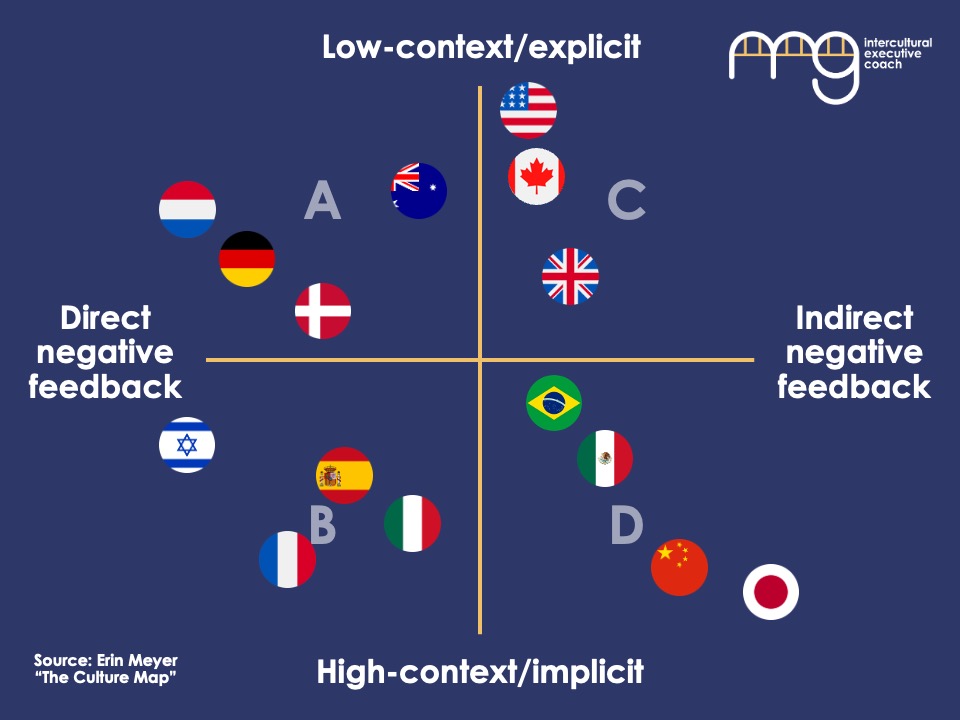As a business leader, one must always aim to foster growth and continuous improvement in their teams through effective performance reviews. All types of companies do these reviews – some more formal, some less. Feedback is an essential tool for individual development, team improvement, and organizational success.
In a multicultural setting, however, differences in cultural interpretations of communication, top-down authority, and social norms can become bumps in the road to effective feedback.
Although we’ve talked about the topic of feedback through the lens of Hofstede’s Dimensions, today we’ll be expanding the conversation by looking at the Evaluating dimension from The Culture Map. In this book, author Erin Meyer explores how different cultures give feedback and critique.
Sometimes, feedback is delivered directly and openly, while in others, it is given more subtly and diplomatically to preserve harmony. Understanding where your team members or colleagues fall on this spectrum is essential for leading effectively across borders. The way we evaluate can help develop trust with your peers or, if applied incorrectly, can lead to confusion and misunderstandings.
Managing The Evaluating Dimension in Different Cultures
The way feedback is given varies greatly across cultures: the difference between direct vs. indirect feedback is important. Here are some of the main differences exposed by The Culture Map and its Evaluating dimension.
- Direct feedback cultures: like the Netherlands, France, Germany, and Israel. In these cultures, frank, straight, and explicit criticism is valued. Negative messages are not softened – upgrading words are used to emphasize the feedback, such as “absolutely” inappropriate, or “totally” non-factual.
- Indirect feedback cultures: like Japan, China, Brazil, and Mexico. Criticism in these cultures is softened and often wrapped in positive comments. Never criticize in front of others. Blurry messages are frequent in Asian countries. Downgrading words may be used, like being “slightly” behind schedule, or “kind of” off track.
- Intermediate cultures: like the United States and the United Kingdom. For instance, Americans are relatively direct but tend to mix criticism with positives. The famous Sandwich Method covers praise-criticism-praise, where constructive feedback is delivered between two layers of positive evaluations. It aims to soften the impact of and make the receiver more receptive to improvement suggestions.
The Connection between Communicating and Evaluating

Although we often assume that cultures with indirect communication styles also give critiques indirectly, this isn’t always the case. As I’ve mentioned in a past piece, the Communicating dimension reflects how explicit or implicit a culture is in general conversation, while the Evaluating dimension refers specifically to how directly negative evaluations are delivered.
For example, the French and Russians use high-context communication but are surprisingly direct when giving criticism. In contrast, Americans are seen as direct communicators overall but tend to soften negative feedback. Cultures like Israel combine implicit communication with very direct evaluation. Understanding where a culture falls on both dimensions helps leaders adapt their approach to evaluations, balancing clarity with cultural sensitivity.
Leadership Takeaways for Giving Feedback
Understanding these differences can be the key to building more resilient, trustworthy, and successful teams in a world where remote and global work is the norm. Here are some strategic takeaways for leaders:
- Adapting your evaluation style strengthens intercultural trust: the importance of adjusting communication to the cultural context. A successful intercultural leader knows when to be explicit and when to soften the message.
- The wrong feedback style can damage relationships and performance: A short example is the use of harsh evaluations might be seen as offensive in more indirect cultures. Be careful of mistaking being too direct with being insensitive. The most direct cultures will direct criticism in a positive manner.
- Frequent, impromptu conversations can help. Formalized ones will always be key. Timely, specific feedback with real interest and care for your collaborators will take you to the best results.
- Hidden feedback: Another circumstance that should be considered is the gap between the evaluations leaders need and what they actually hear
Not all negative feedback is the same – it’s important to understand how to interpret criticism, depending on your region or the culture. When unsure, let the local culture guide you. Pay close attention to how others communicate, their preferences and adjust your style to match. Even small shifts in how you engage can go a long way in building trust and improving collaboration across cultures.



